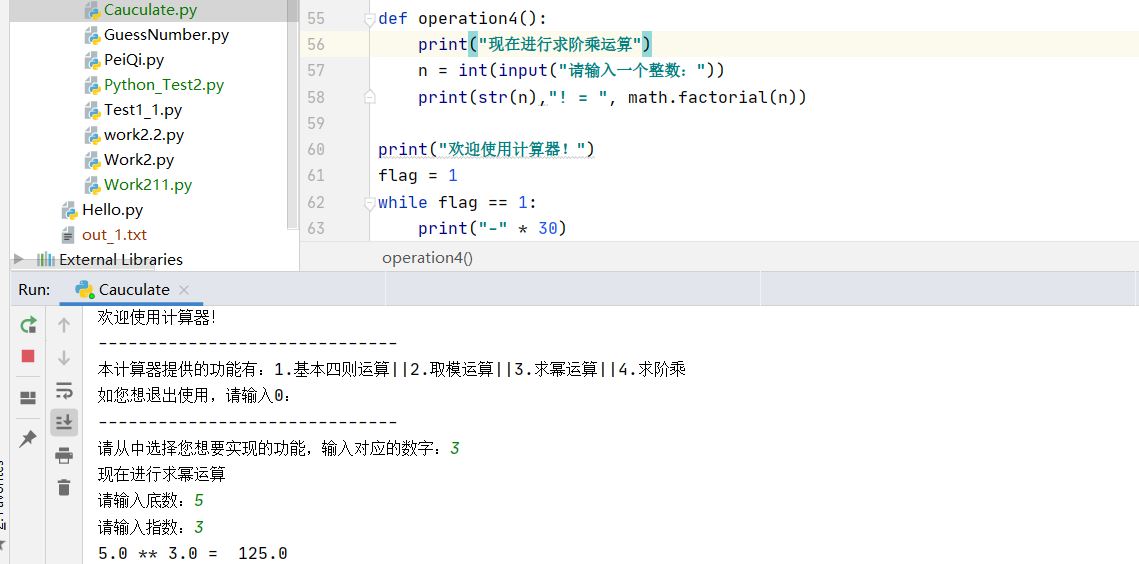20182304张子正 2020-2021-2 《Python程序设计》实验二报告
20182304张子正 2020-2021-2 《Python程序设计》实验二报告
课程:《Python程序设计》
班级: 1823
姓名: 张子正
学号:20182304
实验教师:王志强
实验日期:2021年4月29日
必修/选修: 公选课
1.实验内容
(一)实验内容
- 设计并完成一个完整的应用程序,完成加减乘除模等运算,功能多多益善。
- 考核基本语法、判定语句、循环语句、逻辑运算等知识点。
2.实验过程及结果
设计与实现
-
设计思想:用函数的形式分别实现不同功能模块,最后整合在一起。
-
四则运算
- 注意除数不能为0,用while循环进行检查。
def Cal1(a, b, operator):
if operator == "+":
return a + b
elif operator == "-":
return a - b
elif operator == "*":
return a * b
elif operator == "/":
return a / b
def operation1():
print("现在进行基本四则运算")
operator = input("请输入运算符号:+,-,*,/:")
a = int(input("输入前一个数: "))
b = int(input("输入后一个数: "))
while b == 0 and operator =="/":
print("输入错误!除数不能为0!")
b = int(input("重新输入后一个数: "))
print(str(a) + operator + str(b) + " = ", Cal1(a, b, operator))
- 模运算
- 注意运算性质,利用while判断,p必须为正整数,q为整数且不能为0。
def operation2():
print("现在进行取模运算")
print("请按照提示输入取模运算的两个操作数")
x = int(input("请输入正整数p:"))
y = int(input("请输入整数q:"))
while y == 0 :
print("输入错误!q不能为0!")
y = int(input("请重新输入整数除数q:"))
while x < 0 :
print("输入错误!p必须为正整数!")
x = int(input("请重新输入正整数p:"))
print(str(x) + " Mod " + str(y) + " = ",x % y)
- 幂运算
def operation3():
print("现在进行求幂运算")
a = float(input("请输入底数:"))
b = float(input("请输入指数:"))
print(str(a) + " ** " + str(b) +" = ", a ** b)
- 求阶乘
def operation4():
print("现在进行求阶乘运算")
n = int(input("请输入一个整数:"))
print(str(n),"! = ", math.factorial(n))
- 解一元二次方程
- 注意区分各种情况,要考虑虚数。
def operation5():
print("现在进行解一元二次方程")
a = float(input("请输入a:"))
b = float(input("请输入b:"))
c = float(input("请输入c:"))
d = b*b - 4*a*c
if d >= 0:
x1 = (-b+math.sqrt(d)) / (2*a)
x2 = (-b-math.sqrt(d)) / (2*a)
if d == 0:
print("X1 = X2 = "+str(x1))
else:
print("X1 = "+str(x1)+'\t'+"X2 = "+str(x2))
else:
x1 = str(-b/(2*a)) + '+' + str(math.sqrt(-d)/(2*a)) + 'i'
x2 = str(-b/(2*a)) + '-' + str(math.sqrt(-d)/(2*a)) + 'i'
print("X1 = "+x1+'\t'+"X2 = "+x2)
- 主函数
if __name__ == "__main__":
print("欢迎使用计算器!")
flag = 1
while flag == 1:
print("-" * 30)
print("本计算器提供的功能有:1.基本四则运算||2.取模运算||3.求幂运算||4.求阶乘")
print("如您想退出使用,请输入0:")
print("-" * 30)
a = int(input("请从中选择您想要实现的功能,输入对应的数字:"))
if a == 1:
operation1()
elif a == 2:
operation2()
elif a == 3:
operation3()
elif a == 4:
operation4()
elif a == 5:
operation5()
flag = int(input("继续请输入1,退出请输入0:"))
print("成功退出计算器!")
实验结果
-
四则运算
![]()
-
模运算
![]()
-
幂运算
![]()
-
求阶乘
![]()
-
解一元二次方程
![]()
码云链接
3. 实验过程中遇到的问题和解决过程
-
问题1:没有将Python和之前学过的语言完全区分开,比如说Python与操作是and,Python没有数据类型,需要强制转换,Python中if\while要注意缩进问题与冒号。
- 问题1解决方案:编译器报错后及时查找课本,参考正确语法。
-
问题2:参考之前学过的Java与C,想用switch/case语句实现计算器功能,似乎不可行。
- 问题2解决方案:查阅相关资料,发现与Java、C\C++等语言不同,Python中是不提供switch/case语句的,只能寻找代替方案,最终使用if…elif…elif…else 实现switch/case功能,感觉代码有点冗余。当然也可以用字典实现,但是程序简单,没有必要。
-
问题3:一元二次方程实现相对困难,缺乏思路。
- 问题3解决方案:将之前写过的C的一元二次方程改为Python即可。
其他(感悟、思考等)
- 由于本人没有涉及过于复杂的功能,所以本次实验相对简单,要注意的是掌握每个运算的性质 ,保障正确的输入与输出,测试时要重视边界值测试。
- Python与之前学过的语言稍有差异,应该多加练习,更好的掌握这门语言。
- 使用函数与模块化设计思路能够使编程结构清晰,思路简洁。









 浙公网安备 33010602011771号
浙公网安备 33010602011771号